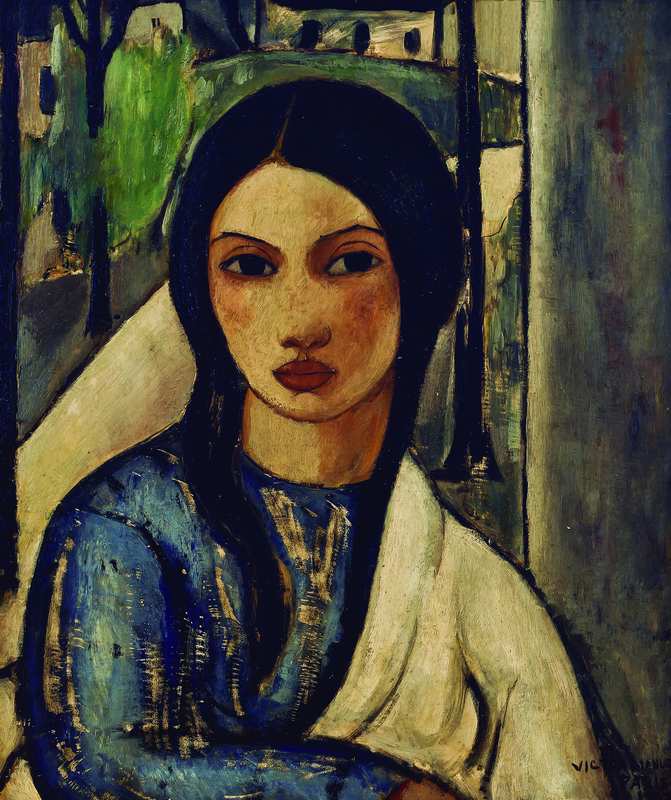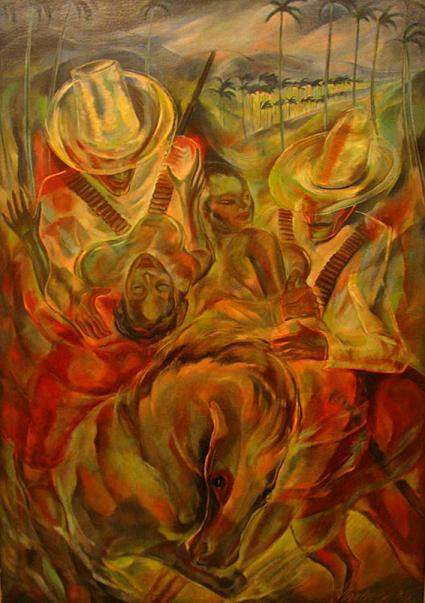A VANGUARD BETWEEN “MULATAS” AND STAINED GLASSES
The first avant-garde in Cuban art of the 20th Century
– Virginia Alberdi Benítez –
Chronological time does not always conform to the real time. An English historian said the European twentieth century began with the bombing of Sarajevo and the outbreak of the First World War in 1914 and ended in 1989 with the fall of the Berlin wall.
The latter date also marked the end of the Cuban 20th Century- the Antillean nation, thereafter, has been and is a different one, even if it is also still the same- but the beginning goes back before saying good-bye to the official calendar of the previous century.
The first day of 1899, indeed, Cuba was under the government of U.S. occupation troops that had intervened in the war fought by Cubans against the Spanish colonial metropolis and that event was the starting point of a new stage in the history of this country.
Three years later, in 1902, the Republic of Cuba was born at last, not very different from the colony regarding its cultural life, although it was increasingly dependent on the nascent American powerful country.
In the Visual Arts, curiously, the influence of the American neighbor was not felt until several decades later. Painting and sculpture of the first Republican years followed the guidelines of the European Academy, dominated by a realistic aesthetics and the practice of landscape, customs scenes and portraits.
The pictorial patterns were fixed by Madrid and Paris, and in sculpture, the Italian statues were followed. It is clear that the Paris meridian was not the one that moved toward the avant-garde breakings, not even the one that was established some time before by the masters of Impressionism.
Even so, within the academic environment, whose center was in the San Alejandro Academy of Arts, we cannot ignore the impression of remarkable painters, such as Armando Menocal (1863-1942), Leopoldo Romañach (1862-1951) and Esteban Valderrama (1892-1964). Their works of art can be enjoyed in the Museo Nacional de Bellas Artes (National Museum of Visual Arts) and other institutions, such as The Museum of Revolution (former Presidential Palace), the Aula Magna of the University of Havana and the gallery opened by the Office of the Historian of Havana at the College of San Geronimo.
Armando Menocal had fought in the Independence War and one of his more famous paintings shows the fall in combat of General Antonio Maceo, one of the heroes of that epic.
Craft refined and with a sumptuous palette, Esteban Valderrama highlighted for the photographic fidelity of his portraits and for giving an allegoric air to his landscapes. Romañach, who unlike his colleagues, did not travel to study in Madrid, but in Rome, was the painter who approached the most to the impressionists influences in his seascapes and influenced his disciples in the use of colors.
Cuban painting only began to stand out after the twenties, when a new generation assimilated the innovations of the European avant-garde of the Twentieth Century in search of their own language with strong nationalist connotation.
These artists have been considered as masters of the first Cuban avant-garde, were inserted into an intellectual movement of greater scope, linked to the need to rescue the republican values, clean up the political practices and to relocate Cuba in the Latin American context. Such objectives were confirmed even more after the accession in 1925 to the presidency of the Republic of Gerardo Machado, who established a dictatorship.
We can have an idea of the social climate of the time when we know the emergence and rise of a radical anti-oligarchic and anti-imperialist thinking in the Academic environment and the role of the labor union movement that led to various branches of socio-political character and therefore, also of cultural character.
The vanguard desires not only encouraged the most advanced painters, but also musicians and writers. The conscience of the African influence in the forging of the Cuban nationality and the cultural fusion was the common denominator among the compositions of Amadeo Roldán and Alejandro Garcia Caturla, the poetry of Nicolas Guillen, the anthropological research of Fernando Ortiz and the first stories of Alejo Carpentier.
So, Victor Manuel Garcia (1897-1969) realized that mixed condition upon his return from Europe, where he had learned to admire Paul Gauguin, Paul Cezanne and Vincent Van Gogh. The face of the women he painted show soft and oval traits that show a fusion of ethnic origins. His most famous paintings are Gitana Tropical (Tropical Gypsy) and Mujer sentada (Seated Woman). The modernity of his painting is also evident in the geometry of his landscapes.

Víctor Manuel García: Gitana Tropical (ref: dev.cured.cu)
To a certain extent related to Victor Manuel through the influence of Gauguin, the painter from Havana Victor Gattorno (1904-1980) insisted on giving symbolist traits to his typical scenes, where the individuals appear with solid volumes and a pastoral attitude.
Eduardo Abela (1889-1965) looked at the Cuban countryside. While the traditional painters of landscapes used to paint forests, meadows and waterfalls without humans, Abela was interested in the people living in the rural environment. Guajiros (Farmer), a painting of 1938, is emblematic for its composition and lyrism. At this stage, it is possible to note the influence of the powerful Mexican mural paintings in his work.
Amelia Peláez (1896-1968) dedicated much of her work to show a very particular and Cuban vision of still life paintings. She got rid of what she had seen in Paris (Braque, Matisse, and the early Picasso) and began to create a new language in Cuban painting. From fruits and flowers, she passed to recreate the ornamental elements of interior architecture: screens, gratings, stained glass. She always looked in all that the way of balancing the decorative opulence and the maximum construction accuracy.
In his short life, Aristides Fernandez (1904-1934), who also dabbled in avant-garde literature, painted some of the most intense pictures in the renewal panorama of the visual arts in Cuba, such as La familia (The family), a group portrait of remarkable psychological exploration with a rural landscape just suggested in the background.

Carlos Enríquez Gómez: El rapto de las mulatas (ref: dev.ecured.cu)
The great renovator of this first group of avant-gardes was Carlos Enriquez (1901-1957) who lived and travelled in Europe for several years but chose to develop the major part of his career in Cuba. He had been close to Cubism and Surrealism, took from those what interested him and found a way of painting where sensuality, hurricane-like movements and transparencies determined the warmth of the atmosphere of his paintings. That can be seen in his works of art El rapto de las mulatas (The rapture of the mulatas) and El combate (The combat).
Havana, Autumn 2015




